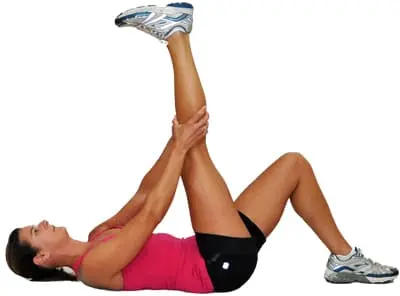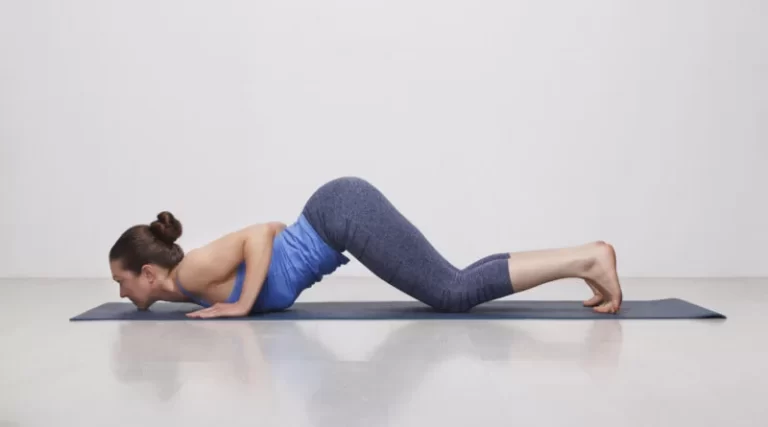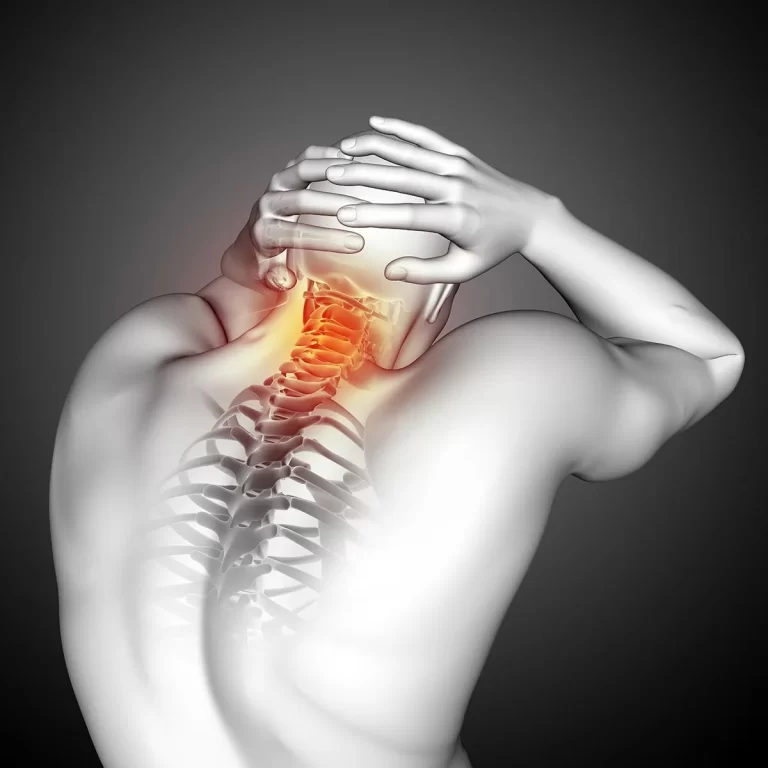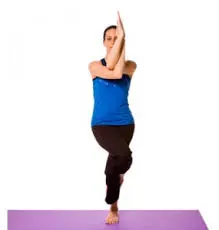36 Best Exercises For Pulled Hamstring Muscles
A pulled hamstring, also known as a hamstring strain, is a common injury that occurs when the muscles at the back of the thigh are stretched beyond their limits or torn.
This injury can result from activities that involve sudden acceleration or deceleration, as well as improper warm-up or muscle imbalances. Recovering from a pulled hamstring requires a careful balance of rest and targeted exercises to promote healing and prevent further injury.
Introduction
An injury in one of the hamstring muscles at the back of the thigh is known as a “pulled hamstring” or strain. The muscles insert into the rear of the shin bone (tibia) after emerging from the lower portion of the pelvic bone (ischial tuberosity).
They assist in extending the hip (moving the leg backward) and bending (flexing) the knee when they contract. Muscle workouts for the hamstrings are part of extensive training in their daily routine. Usually, the purpose of these exercises is to strengthen the hamstrings.
Strains in the hamstring muscles are a typical sports injury. When a muscle is overworked or overstretched, a strain occurs. Grades 1, 2, and 3 are the three different types of strains.
- Grade I: The muscle heals fast and there is minimal structural disturbance.
Only a small number of the muscle’s fibers are broken or torn. The strength and endurance of the muscle are not often affected by this. Depending on the individual, pain, and sensitivity usually start the day after the injury. The most common complaint from patients is back leg stiffness. Patients are able to walk normally. The knee can still bend normally even with a slight amount of swelling.
- Grade II: A partial rupture is present.
Roughly 50% of the fibers are broken. Acute pain, edema, and a slight loss of function are the symptoms. The patient’s walking will be affected. Applying specific pressure to the hamstring muscle or bending the knee against resistance are a couple of methods to simulate pain.
- Grade III: This suggests a total tear in the tissue and a protracted healing period.
Various from the muscle rupturing completely to more than half of the fibers. This injury can affect the tendon as well as the torso muscle. It hurts a lot and causes massive swelling. The hamstring muscle shows extreme weakness and is no longer able to perform its function.
Exercises for hamstring rehabilitation can speed up healing and protect against further injuries. Most rehabilitation procedures include a mix of strengthening and stretching exercises. Exercises for strengthening your hamstrings can be done at home without any specialized equipment and are first introduced in a rehab program.
Workouts for stretching the hamstring muscles can be either static or dynamic. Stretching into a position and keeping it for a while is the goal of static exercises. To stretch your muscles, use dynamic stretching techniques such as movement or gentle leg swings.
Do not start exercises if you have a pulled hamstring until you are certain that the acute phase of the injury is over.
What exercises are used for hamstring rehab?
Exercises for hamstring rehabilitation include a variety of movements to promote healing and strength restoration. Stretching exercises such as hamstring stretches performed while seated, standing, or supine are frequently used to increase flexibility. Exercises that target the muscles to regain strength and stability include bridges and hamstring curls.
Rehabilitation of Hamstring Strains:
PHASE 1: Acute Phase
Goals:
- Reduce discomfort and swelling
- Improve ROM and flexibility bit by bit.
- A decrease in muscle mass and loss of strength
- Promote the healing procedures for pulled muscles
PHASE 2: Subacute phase
Goals:
- ROM and flexibility are the goals here.
- Boost your muscles’ power and stamina.
- Encourage the healing of damaged structures
- Reduce any pain and inflammation
PHASE 3: Dynamic phase
Goals:
- Increasing the hamstrings’ dynamic (ballistic) flexibility
- Apply static flexibility generally
- Bring back to normal muscle strength
PHASE 4: Sports Particular and Skill Development Phase
Goals:
- Bring ballistic flexibility back to normal.
- Return to normal muscle strength and flexibility.
- A gradual transition in direct involvement
Best exercises for pulled hamstring muscles
This rehab treatment for Hamstring injury includes the following exercises. They consist of functional, strengthening, and stretching exercises that should be performed in addition to therapy techniques. To enhance performance and lessen the risk of injury, they are also perfect for strengthening the hamstring muscles.
The discomfort might rise at first as a result of these workouts. Don’t worry; just begin with fewer sessions the following time and gradually increase. Your physical therapist will advise you on the appropriate number of repetitions.
Some of the best workouts for pulling the hamstring muscles are listed below.
Straight leg hamstring stretch
- When sitting on the ground or in bed, keep your posture straight.
- With the leg you wish to stretch extended, straighten your knee joint and plant your heel on the floor with your toes free and pointed upward.
- Maintain a flat back and bend forward at the hips as you shift your weight forward.
- Until you feel a stretch in the back of your leg, keep bending your trunk forward.
- Continue your position like this for a short while.
- Return to your neutral position
- Next, unwind.
- Continue with the opposite leg.
- Do this five to ten times over.

Hamstring swings
- Place your feet hip-width apart in order to perform hamstring swings.
- Increase the range of motion gradually by swinging one leg forward and backward.
- To prevent stress or loss of balance, start with small swings and gradually increase the intensity.
- You should also maintain good balance and refrain from jerking or excessive momentum.
- Return to your neutral posture after that.
- Then relax.
- Continue with the other leg.
- Repeat these procedures five to ten times.
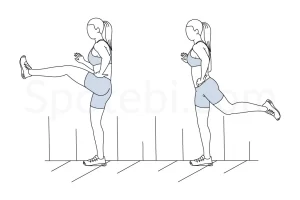
Straight leg raise
- Take a comfortable supine posture on the floor or table to start.
- Now flex one knee.
- Then raise your leg gradually.
- While maintaining the straight opposite knee.
- Then hold for a few more seconds.
- Lower your leg after that.
- Return to your neutral position gradually.
- Next, relax.
- On the other side, repeat.
- Five to ten times over.

Upside downcycling
- Lay flat on your back with your feet gently pointed and your legs extended straight up towards the ceiling.
- Take a deep breath to center yourself, then exhale slowly as you lift your legs above your body and raise your spine one vertebrae at a time.
- Put your hands behind your pelvis while keeping your elbows and upper arms on the floor to support your pelvis.
- Lift your legs to the ceiling so that they are 90 degrees from the ground.
- Stretch your right leg to the floor while bringing your left leg up to your chest.
- Bend your right knee and drop your heel to your buttocks.
- It should feel like you’re riding an upside-down bike.
- Bring your bent right leg forward, extend your left leg back, straighten your left leg, and drop your left heel toward your buttock.
- Bring the legs back together and straight to the finish, then gradually lower the spine to the floor.
- Then, go back to your neutral position.
- Next, unwind.
- Five to ten times over, repeat these steps.
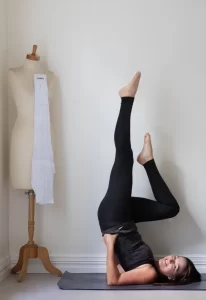
Lying Crossover Stretch
- Arms relaxed by your sides, lie on your back.
- Plant your left foot flat on the ground and flex your left leg.
- Spread your arms wide until your body forms a cross or the letter “T.”
- Lean your head to the left and lower your left leg over your right.
- Attempt to maintain a level upper back on the ground.
- For a short while, hold this position.
- Return to your neutral posture after that.
- Then relax.
- Proceed with the other leg.
- Repeat these actions five to ten times.
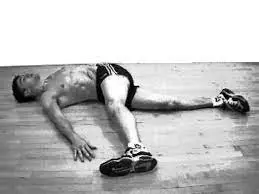
Hamstring Curls with Resistance Band
- Place yourself in the center of the looped band, then surround your other ankle with the other end.
- Take a tall stance and engage your core.
- Stretch your bandaged leg back while maintaining a straight knee.
- Bend your ankle slowly in the direction of your glute.
- Squeezing your hamstrings and glutes.
- Keep your position like this for a short while.
- Return to your neutral posture after that.
- Then relax.
- Proceed with the other leg.
- Repeat these actions five to ten times.
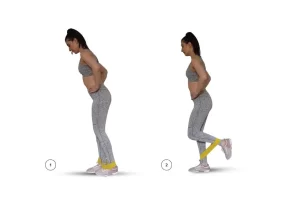
Bridges
- Start by lying down on the bed in a comfortable posture.
- Bend your knees and place your feet flat on the bed’s surface.
- Next, tighten the muscles in your abdomen.
- Lift your body upwards.
- Do not raise your arms above your heads.
- Hold on for a brief while.
- Reduce the level of your body.
- Then, go back to your neutral posture.
- Next, unwind.
- You should perform this exercise five to ten times.
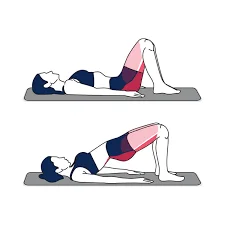
Seated hamstring pull
- Attach the ends of a resistance band to a stuffed piece or exercise machine, or any other sturdy object.
- Prior to the band, take a seat.
- Maintaining your feet together, wrap the loop around one of your heels.
- Pull your heel back by bending your knee and stopping when you are unable to pull any farther.
- Hold on for just a few seconds.
- Return to your neutral position after that.
- Then relax.
- Five to ten times over, repeat these steps.
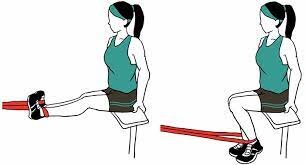
Single leg bridge
- Having your hands flat on the floor and your arms at your sides, lay down on an exercise mat.
- Your feet should be flat on the floor, a few inches away from your buttocks, as you bend your knees.
- Lift one leg and bend the knee to a comfortable position.
- Inhale, then bring your hips upward by pressing through the heel of your other foot.
- This engages your posterior chain.
- Stretch your hips until your shoulders and knees are in alignment.
- Exhale as you lower your buttocks to the floor after holding the top position for a brief period of time.
- Return to your neutral position after that.
- Then relax.
- Five to ten times over, repeat these steps.
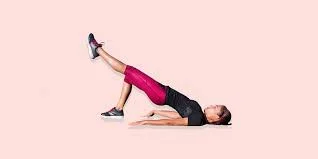
Lunge With Medicine Ball Pass
- Keep the ball close to your chest while adopting a wide split stance.
- As you simultaneously move the ball to the inside of your front leg and swiftly pass it from hand to hand under your leg, bend both knees and lower yourself into a lunge.
- Straighten both legs and pass the ball back over your leg.
- That amounts to one rep.
- Perform steps 5–10, then relax.
- Continue on the opposite side.
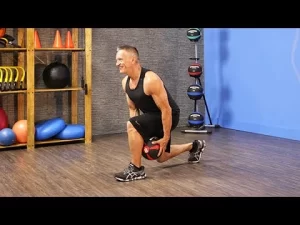
Leg Press on the Ball
- Sit on a large exercise ball.
- Step out with your feet until your torso is inclined over the ball.
- You’ll be off the ball with your head and shoulders.
- Avoid looking up or down and maintain a natural neck posture.
- You’ll have arms by your sides.
- As though you were going to perform a squat, bend your knees.
- Next, push through your heels to get back to the starting position while concentrating on tightening your hamstrings.
- For a few seconds, hold on for position.
- Then, go back to your neutral posture.
- Next, unwind.
- Repeat these steps five to ten times.
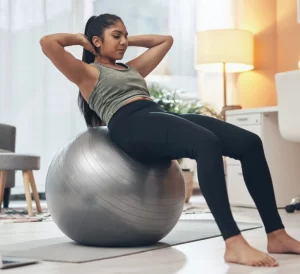
Hamstring wall Stretch
- You should lie on your back at the entrance with your healthy leg through the wall.
- Take your harmed leg up the wall to straighten it.
- Your leg should feel slightly stretched at the back.
- Avoid hunching your back.
- Don’t bend any knee.
- Preserve the position of one heel against a wall and the other on the ground.
- Avoid pointing your toes.
- For a few seconds, remain in this posture.
- Return to your neutral position after that.
- Next, unwind.
- Five to ten times more, repeat.
- Using the other leg, perform the exercise again.

Sitting Heel Dig
- Take a seat at the leading edge of your chair or bed.
- Reach out with your right leg first, placing your heel on the ground, and work your way up to the other leg.
- After that, you turn your heel back toward you.
- You’ll feel your muscles firing harder the deeper you press your heel into the ground.
- Go slowly at first, then increase the pressure.
- Return to your neutral position after that.
- Next, unwind.
- Perform five to ten repetitions per leg on alternate.

Standing kickbacks
- Press the palms of your hands against a wall counter, or box that is 1-2 feet away from you.
- Lean slightly forward with your left foot off the ground and your knee bent.
- Make sure you have a straight back and a tight core.
- Contract your glutes as you extend your leg backward at an angle of between 60 and 90 degrees.
- For a few seconds, remain in this posture.
- Place your leg back where it was initially. This counts as one rep.
- Next, unwind.
- Perform five to ten repetitions per leg on alternate.
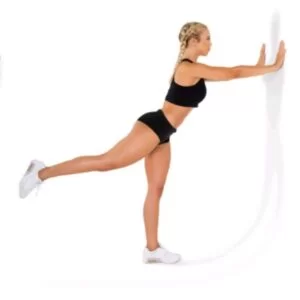
Standing Toe Touches
- Having your toes pointing forward and your feet shoulder-width apart, assume an upright position.
- Maintain straight legs and slightly bent knees, with arms extended down by your side.
- This is your starting position.
- Bend forward at the torso, keeping your body loose, and allow your fingers to hang down toward your toes.
- Hold for a few counts, then return to your starting position.
- Next, unwind.
- Perform five to ten repetitions per leg on alternate.
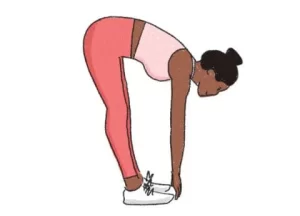
Swiss Ball Hamstring Curl
- Placing a swiss ball beneath your feet, lie on your back.
- Keeping your hands by your sides and your palms flat on the ground.
- Lift your torso off the floor.
- Everything starts at this point.
- Position your feet so that the soles face upwards.
- You should be fully extended with both legs.
- Bend your legs inward to bring the Swiss ball closer to your hips.
- As you carefully roll the Swiss ball back to the starting position, extend your legs.
- Proceed to your neutral position after that.
- Then unwind.
- Five to ten times more, repeat.
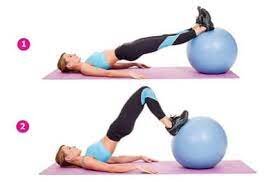
Calf stretch (back knee straight)
- Placing your hands on the wall, face the wall.
- Another way to accomplish this is to put your hands on the back of a chair or counter.
- Pull your toes forward and place one leg about a step behind the other.
- Maintaining your back leg straight and your heel on the floor, bend your front knee.
- Unless you feel a stretch in the calf of your back leg, gently bring your hip and chest toward the wall.
- Hold for a few counts before stepping back to where you were before.
- Then relax.
- Do five to ten alternate reps for each leg.

Bulgarian Split Squat
- Put your back on your “bench” as you stand.
- Plant the top of your right foot, shoelaces down, on the bench while your left foot is on the ground a few feet in front of it.
- Make sure your hands are relaxed and your core is active.
- If it is more comfortable for you, you can alternatively keep your hands by your sides or clasp them together at your chest.
- To get into a split squat, bend your knees.
- In an ideal situation, your right knee should be elevated above the floor and your left knee should make a 90-degree angle with your thigh parallel to the ground.
- To return to your starting posture, push through your left heel.
- After that, move on to your neutral posture.
- Next, relax.
- Once the 5- 10 reps are finished, switch sides and continue.
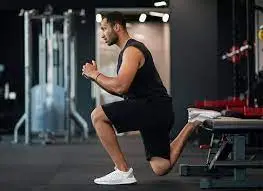
Prone knee bend
- Lay on a mat with your back to the floor.
- Put your arms in front of you.
- Remain relaxed with your legs and trunk.
- Place your left leg flat on the mat and raise your right leg as high as you can with a slow, pleasant bend.
- Aim to maintain a stable hip position throughout the exercise.
- At the same time as you lower your right leg, raise your left leg.
- Repeat this carefully and gently alternating leg movement five to ten times for each leg.
- Go back to where you were before.
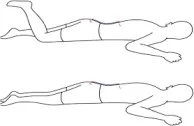
Chair lift
- Place a chair behind your heels as you lay on your back.
- Lift your hips from the floor.
- preserve this position.
- After that, take a neutral stance.
- Next, unwind.
- This exercise should be performed five to ten times a day.
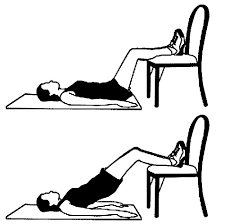
Lunge
- Place your feet hip-width apart as you begin in a standing position.
- Take a step forward that is longer than a walking stride, placing one leg in front of you and the other behind your body.
- Your foot should be touching to touch the ground flat and stay that way throughout.
- Your back heel will lift off the surface.
- As you lower yourself, bend your knees to about a ninety-degree angle.
- Don’t forget to maintain an engaged core and an upright trunk.
- After that, firmly push off with your front leg to get back to the starting posture.
- Next, unwind.
- This exercise should be performed five to ten times a day.
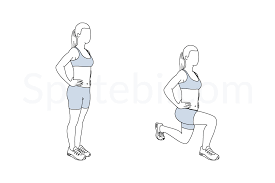
Standing hamstring stretch
- Keep an equal spine and a straight back when standing.
- Through the foot flexed, heel pressed into the ground, and toe pointing upward, bring the right leg forward in front of the body.
- Bend the left knee a little bit.
- Lean forward gently and rest your hands on your right leg.
- Maintain a neutral stance.
- After that, take a neutral stance.
- Next, unwind.
- Alternate your legs.
- Do each leg five or ten times over.

Lying hamstring stretch using a strap
- Through your legs extended, lie flat on the ground or a mat.
- To straighten the right leg, flex it and place the band through the ball of the right foot.
- Use both hands to hold the strap.
- Keep your left leg stretched out and your foot extended against the floor.
- This ought to move the thigh and calf toward the floor.
- Keeping up your foot bent slowly extend your right leg.
- The right leg ought to be straight with a small knee bend.
- The foot’s bottom ought to be facing the ceiling.
- Gently pull the strap until your hamstrings are just a little bit tight.
- Stretch for a few seconds.
- After that, take a neutral stance.
- Next, unwind.
- Change your legs.
- Repeat each leg five to ten times.
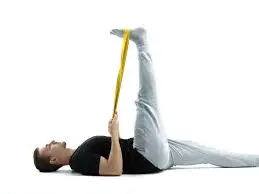
Hip Adduction- Ball Squeezes
- Through your shoulders back, chest out, and back straight, take a tall stance at the end of a bench.
- While your knees are bent, your feet should be flat on the floor.
- In between your knees, place a ball.
- Try to bring your knees closer together to squeeze the ball.
- Take a few seconds to hold.
- Without letting go of the ball, return your knees to the beginning position.
- After that, take a neutral stance.
- Next, unwind.
- Repeat five to ten times.
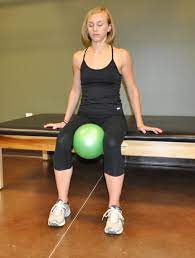
Standing hamstring curl
- Place your feet on the floor while standing.
- For balance, rest your hands on your waist or a chair.
- At this point, your left leg should be supporting your weight.
- Having the heel moving toward the butt, carefully bend your right knee.
- Keep your thighs parallel.
- Gradually bring your foot down.
- Next, unwind.
- Continue with the opposite leg.
- Do this five to ten times over.

Single-leg deadlift
- Start by placing your feet parallel to the floor and hip-width apart.
- Leaning forward with your hips, place your weight on one leg while keeping your other leg straight behind you.
- Elevate your extended leg and bend forward until your body forms a “T” shape.
- Your arms must hang straight down while you are bearing the weight.
- As you stand, keep your leg slightly bent.
- Preserve this position for a short period of time.
- Return your extended leg to its initial position slowly.
- Next, unwind.
- Do this five to ten times over.
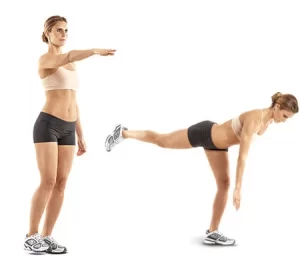
Half-kneeling hip flexor stretch
- Drop to your knees on the ground with your left foot flat in front of you and your right knee on the ground behind you.
- Try to maintain a tall trunk during this exercise.
- You may maintain your hands allowing on your left knee for balance.
- Gently move your right knee back up to your front hip stretch a little.
- Bring your hips and trunk toward your left foot by contracting your right glute as though you were pushing forward.
- In order to create a pelvic tilt, tuck your hips slightly.
- Breathe deeply, then hold this position for a few seconds.
- Keep your position like this for a short while.
- Slowly bring your extended leg back to its starting position.
- Then relax.
- Repeat each of these actions five to ten times.
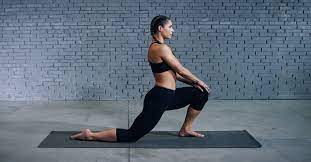
Chair Walks
- Take a seat on a hard surface in an office chair.
- Leaning back on the chair, slowly extend your leg.
- Pulling the chair or body forward while planting the heel in the ground
- Stretch your injured leg once more, then repeat.
- Return your extended leg to its starting position slowly.
- Next, unwind.
- Each of these processes should be done five to ten times.
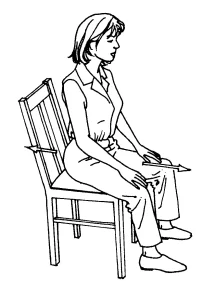
Prone hip extension on the stability ball
- Place your hips or lower abdomen on the ball.
- Your toes should lightly touch the ground, and your legs should hang off the back of the ball.
- Through your arms straight, place your hands on the ground in front of the ball.
- Raise the feet away the ground and bring them into position with your upper body by tightening your glutes.
- Maintain contact with the ball and an engaged core.
- Keep your knees straight and refrain from extending your lower back.
- Return your legs to the starting position by lowering them gradually.
- Then relax.
- Repeat each of these actions five to ten times.
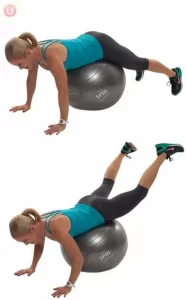
Hip flexor stretch on chair
- Put your right foot on the chair that is in front of you.
- Put your hands on your hips on either side.
- While maintaining an upright chest, flex your pelvic floor and core.
- Bend your right knee and slowly push your hips forward until your muscle stretches.
- Take care not to hunch your back.
- Hold the stretch for the necessary amount of time.
- Return your leg to its initial position gradually.
- Next, unwind.
- Five through ten times over, repeat the steps.
- Switch to the other side.
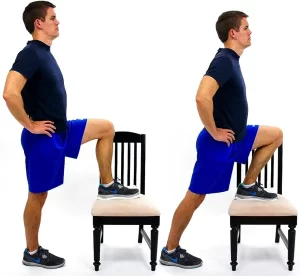
Squats
- Beginning on the ground, adopt a relaxed stance.
- Maintain your center of attention.
- Draw in a breath.
- Put your knees straight.
- Assume equal weight on both legs and bend your knees to a minimum of 90 degrees.
- Sustain a straight back.
- For a few seconds, maintain this posture.
- Once again, take a neutral stance.
- After that, unwind.
- Work out five to ten times.
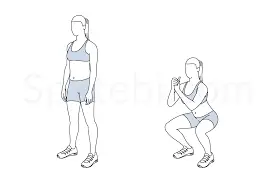
Extension Lag
- Near the bed’s edge, or chair about mid-thigh, sit.
- Avoid putting your legs in contact with the ground.
- Place your hands on the seat.
- Stretch the hurt leg to its maximum length.
- Keep this position in place.
- Next, adopt an impartial stance.
- Then unwind.
- Work out the other leg in the same manner.
- Do this workout five to ten times.
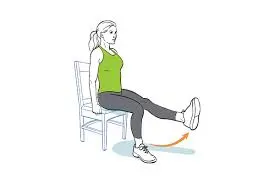
Single Knee to Chest
- Begin by lying on your back on a soft surface, like a bed, blanket, or yoga mat.
- Maintain a relaxed posture with your head and shoulders while holding this stretch.
- Gently pull your left knee in toward your chest with both hands behind it.
- Hold for a duration of few seconds.
- You can keep your opposing leg straight or bend your knee.
- Next, adopt an impartial stance.
- Then unwind.
- After that, let go and raise your right leg while using both hands to grab it behind the knee.
- Take a few minutes to hold the right knee pulled into your chest.
- On both the left and right sides, repeat 5- 10 times.
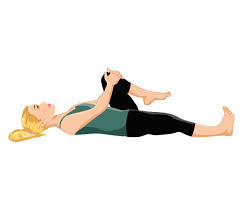
Running High Knees
- Through your arms by your sides and your feet roughly hip-to-shoulder distance apart, take a pleased stance.
- Keep your head up, let your chest drop, and use your core.
- Raise your right knee to about above your waist and into your chest.
- Pump the air with your left hand at the same time.
- Lower your left hand and right leg quickly.
- Proceed in the same manner with your left leg and hand.
- After that, take a neutral position.
- Next, relax.
- For the desired repetition, switch between your left and right leg five to ten times.
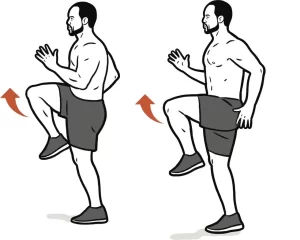
Nordic Hamstring Curl
- Assume a tall, kneeling position.
- Place an object beneath your knees for comfort.
- Have someone hold your ankles down, or use weights.
- Perform the exercise by leaning forward as far as you can control while maintaining a straight trunk and tight core.
- Then, quickly lower yourself to the ground, catch yourself with your hands, and push yourself away from the ground to return to the starting position.
- After that, take a neutral position.
- Next, relax.
- Do this workout five to ten times.
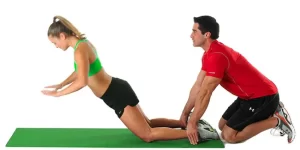
Leg-Straight Hip Extension
- Go on the floor and lie face down, flat.
- While your abdominal muscles are contracted, gradually tighten your core muscles.
- While doing this, breathing should still be possible.
- Raise one leg slowly backward while maintaining straight knees and an engaged abs.
- Once your thigh rises off the floor, maintain a straight knee.
- After a few seconds, release your straight leg from the air and gently lower it back to the ground.
- After that, take a neutral position.
- Next, relax
- Take care when lifting your leg to avoid rotating your pelvis or back.
- Do this workout five to ten times.
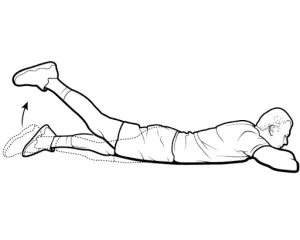
Recovery period following hamstring strain:
The response is unique, just like everything related to recovery. How long it takes to recover depends on a number of factors, including the size, age, associated conditions, compliance, level of exercise, and degree of muscular strain.
Muscle strains on gradual 1 usually show results in a few days or weeks. Concerning grade 2 muscular strains, healing should occur in a few weeks. Surgery is necessary for grade 3 muscular injuries, which prolongs the healing period.
What preventive measures are required when working out?
- It is important to keep proper posture when exercising.
- To make sure your body gets enough time to rest in between exercise sessions.
- Avoid doing intense exercise.
- Before working out, fully warm up.
- If you experience sudden pain when working out, stop.
- Acquire the Appropriate Balance
- Remain hydrated.
What time do you stop working out?
- Intense pain in the muscles.
- You can spread infection.
- If exercising hurts, you should stop.
- A high-temperature fever
- Headaches
Summary
Muscle strains are prevalent conditions in the hamstrings. Though there are more advanced methods like cryotherapy, the RICE method—rest, ice, compression, and elevation—is usually effective in treating them. When the muscle is capable of stretching and strengthening it might aid in its recovery. Paying attention to a physician’s rehabilitation plan and scheduling follow-up appointments with physical therapists is critical.
Severe complications that restrict movement and everyday tasks are hamstring strains. Stretching and exercising as part of proper rehabilitation are essential for healing. As they are recommended to prevent hamstring injuries, stretches that increase hamstring strength and flexibility will be covered. Exercises for building up and extending the body are crucial. If there is no pain after the first acute phase, extremely mild static stretching exercises can start. Dynamic stretching, which requires movement, is added when your injury recovers, and eventually sports-specific activities.
The standing hamstring stretches and an exercise is a gentle approach to stretching your hamstrings immediately. When performing this stretch, make sure that the back of your thigh is only somewhat uncomfortable rather than experiencing any severe pain.
FAQs
After suffering a hamstring injury, it is advisable to speak with a medical practitioner or physiotherapist before beginning any workouts.
Your hamstrings need to be rested in order to heal quickly. During the recovery period, it is important that you gradually increase the amount of time you spend exercising by using your hamstring muscles. To Recover Quicker, You Could Also: Ice the leg to ease the discomfort and swelling.
Patients with mild hamstring strains can resume sports and other activities in a few days to a week or so. It may take an athlete two to six weeks to return to competition after a more serious injury.
Resuming intense exercise too soon could worsen your injury. However, if you stop exercising too soon, scar tissue will grow around the tear and your hamstring muscles will weaken. You should start doing gentle hamstring stretches after a few days in order to prevent this.
You shouldn’t stress out sore muscles by engaging in strenuous, high-intensity exercise because they are already healing and becoming stronger. On the other hand, as you warm the muscles to promote healing blood flow to the tissue, a brief exercise regimen might provide some relief
fortunately, by regularly stretching the hamstrings, you can gradually lengthen these muscles and reduce your risk of injury. To achieve the best results, you should commit to performing one or more hamstring stretches at least twice a day over an extended time, as it takes time and effort to release tight muscles.
Strengthening increases the stability and strength of the hamstring muscle, which helps prevent injuries. To target the hamstring muscles, apply exercises like leg curls, deadlifts, and glute bridges into your routine.
The back of your thigh contains the hamstring muscles, which extend from your hip to your knee. Your lower leg, knee, and pelvic bones are connected to your hamstring tendons.
While walking, swimming, and light cycling are generally safe and will help you regain strength and increase blood flow to the area to aid in the natural healing process, avoid doing any intense physical activity until your hamstrings are fully healed.
This easy-to-do but effective hamstring exercise will help you strengthen them, which will improve your mobility and balance among other things. Enhancing stability in the legs can lower the chance of injury, particularly to the knees and lower back.
Physical therapy may be beneficial for your recovery if you believe you have a hamstring tear or another leg illness. For your hamstring tear, an individually designed physical therapy treatment plan can help you reduce pain, build strength, and increase your mobility and range of motion.
If the patient feels pain in the proximal hamstring area when the examiner quickly flexes their hip and extends their knee while the patient is prone, the test is considered successful.
Athletes frequently suffer from hamstring muscle injuries, such as a “pulled hamstring”. Sports requiring fast running, like basketball, soccer, and track, are particularly prone to them in their athletes. An injury to one or more of the posterior thigh muscles is known as a pulled hamstring or strain.
A torn hamstring can be promptly healed by;
Suitable workouts.
Appropriate stretching.
Gradual improvement under the supervision of a physiotherapist or medical expert.
To effectively treat a pulled hamstring, a physical therapist may use manual therapy, stretches, and exercises.
Your symptoms, the problem’s history, and a hamstring muscle examination are used to make the diagnosis. Typically, tests like X-rays and MRIs are not necessary.
Pain or tenderness in the hamstring muscles.
Swelling in the upper leg.
Difficulty weight bearing.
Difficulty straightening your knee.
Put your leg to rest.
Put some ice on your leg.
Curl your legs together.
Raise one leg.
Take painkillers that reduce inflammation.
Engage in strengthening and stretching activities.
Your leg can move as freely as it did before the injury.
Your hurt leg feels just as strong as your normal leg.
Walking, jogging, sprinting, and finally jumping all cause you to experience zero pain in your leg.
Professional, collegiate, and high school athletes. A higher incidence risk is seen in athletes who participate in track and field, football, and soccer.
Those who have sustained hamstring injuries in the past.
After your injury, if you don’t follow the R.I.C.E. designation, your hamstring injury might worsen. R.I.C.E. represents elevation, compression, rest, and ice.
No.
Your recovery strategy must be followed too. Exercise avoiding for an extended time can cause your hamstring muscles to weaken. Scar tissue might also be present.
Exercise is a usual therapy for back pain that helps to stop future harm and suffering. One type of exercise that helps to strengthen the muscles that support the body is stretching. Regular physical activity can help to lessen the repeated discomfort’s intensity.
Common mistakes to avoid during hamstring strain recovery include not getting enough sleep, ignoring pain, skipping workouts, exercising improperly, not adhering to a recommended treatment plan, and attempting to resume sports too soon.
A hamstring injury has been demonstrated to produce long-term anatomical findings on MRI scans and physical examinations. Incorrect management of high (proximal) hamstring injuries can eventually result in chronic hamstring tendinopathy.
Athletes commonly suffer from hamstring muscle injuries, such as a “pulled hamstring”. They are more common in athletes who play sports like basketball, soccer, and track and field that call for fast running.
The best way to reduce pain, swelling, and inflammation in cases of fresh injuries, re-injuries, and the early post-operative recovery phase is with cold compression. In addition to resting your injury for the first 24 to 72 hours of treatment, cold should also be applied.
Recovery from hamstring strain (3–7 days)
In order to improve cells circulation and muscle fiber flexibility, the heat should be applied for ten to fifteen minutes. The area can be gently massaged right after receiving heat, while the tissue is still warm and soft.
A thirty-second period of hamstring stretching was the best way to improve knee range of motion while reducing the detrimental effects on the affected nerve roots’ neural function. Therefore, stretching the hamstring muscles for sixty seconds straight puts excess stress and strain on the nervous system and needs to be avoided.
A physical therapist can also provide you with advice on when it might be safe for you to resume your regular activities and the best hamstring strain rehabilitation for your specific injury. Although it may take days, weeks, or even months for a hamstring sprain to fully heal, seeing a physical therapist can hasten the healing process.
Depending on the severity of the an injury, people with hamstring injuries may need to take a break from running or sprinting for one to six weeks. If speeding is introduced too soon after suffering a high grade injury, particularly one to the tendon, the person could rupture the injury again.
A few particularly minor hamstring strains heal in a matter of days. However, it usually takes weeks or months for an injury to heal completely. Recovery could take up to a year in certain situations.
Hamstring swings
Leg-Straight Hip Extension
Standing hamstring curl
Chair lift
Single-leg deadlift
Prone knee bend
Single leg bridge
Straight leg hamstring stretch
Hamstring wall Stretch
Hip flexor stretch on chair
Half kneeling hip flexor stretch
Standing hamstring stretch
References:
- N. R. S., physiotherapist (2023, June 1). Sportsinjuryclinic.net: Hamstring Exercises. Pulling hamstring exercises can help with thigh pain and back pain, according to Sports Injury Clinic. Citation within the text: (Physiotherapist, 2023)
- Smith, M. (January 30, 2020). AccessHealth Chiropractic: Rehab Exercises for High Hamstring Injuries. AccessHealth Chiropractic: Rehab Exercises for High Hamstring Injuries. Rehab exercises for hamstring injuries can be found at https://www.accesshealthchiro.com. Reference within the text: Smith, 2020
- Five Corrective Exercises for Treating a Pulled Hamstring | ISSA (n.d.). What to do for a pulled hamstring: Five corrective exercises that you can do Internal Reference: (ISSA, n.d.) “What to Do for a Pulled Hamstring: 5 Corrective Exercises”
- Brahmbhatt, B. July 4, 2023. Exercises for Hamstring Strain Rehabilitation. Exercises for Hamstring Strain Rehabilitation: https://www.physiotattva.com/blog Citation within the text: (Brahmbhatt, 2023)
- M. Monte (2023, Feb. 28). What exercises are used for hamstring rehab? hamstring-rehab-exercises https://www.medicalnewstoday.com/articles/summary Reference inside text: (Monte, 2023)
- Strain in the Hamstrings. 2007 Feb 28. Hamstring strain on WebMD. https://www.webmd.com/fitness-exercise Citation inside the text: (Hamstring Strain, 2007)
- Strain in the Hamstrings. n.d. Hamstring strain on Physiopedia: https://www.physio-pedia.com Citation inside the text: (Hamstring Strain, n.d.)
- Pta, K. B. January 19, 2024. Exercises for Hamstring Strains to Heal Them Quickly! Petersen Physical Rehabilitation. exercises for hamstring strain that can be done quickly to heal a strain Citation within the text: (Pta, 2024)
- C. C. M., Professional (n.d.). Hamstring Strain. https://my.clevelandclinic.org/health/diseases/17039-hamstring-injury Cleveland Clinic
- Image 2, D. (June 8, 2021). Exercise Guide with Illustrations for Forward Leg Swings. Forward-leg swings are an exercise guide available on SPOTEBI. In-text Reference: (2021)
- Image 4, Pattern scissors cloth, April 2021. April 2, 2021. Design Scissors Fabric. /2021/04/patternscissorscloth.com Inside-Text Reference: (April 2021 – Scissors Cloth, 2021)
- Image 5, Stretching for Lying Crossover on ExRx.net (n.d.). /Stretches/Obliques/Lying Crossover at https://exrx.net In-text Citation: (Lying Crossover Stretch, ExRx.net, n.d.)
- Image 6, Hamstring curls with a short resistance band for the legs – FIT CARROTS | High-quality exercise equipment for functional and regeneration training. (November 23, 2019).Fit Cartrons: Premium Workout Gear for Regenerative and Functional Training. Legs: Hamstring curls with a short resistance band: https://fitcarrots.com/exercise/short-resistance-bands/ In-text Citation: (FIT CARROTS | Premium Fitness Tools for Functional and Regeneration Training, 2019) Legs: Hamstring Curls With Short Resistance Band
- Image 10, J. G. T. (March 17, 2015). Pass for Stationary Lunge Med Ball. YouTube. //www.youtube.com/watch?v=yp2ugpCol3Y Internal Reference: (2015)
- Image 11, Roche, D. July 19, 2022. Exercise Ball: Fitness Advice. What is going on? Publications. https://whatsupmag.com/health-and-beauty/fitness/exercise-ball-fitness-tips/ Reference within the text: Roche, 2022
- Image 13, Pathways, F. (Apr 10, 2019). Exercise of the Month: Seated Heel Drag | Functional Pathways | Therapy that exceeds expectations. https://fprehab.com/2019/04/10/monthly-exercise-sat-heel-dragging/ Reference within the text: Pathways, 2019
- Image 29, Cpt, C. F. (November 1, 2016). The Stability Ball Prone Hip Extension Technique. Get Well, U | Chris Freytag. Stability ball prone hip extension exercise: https://gethealthyu.com/ Citation within text: (Cpt, 2016)
- Image 30, Jones, T. July 25, 2019. Hip Flexor Stretches | Medical Massage & Sports in Tampa Bay. Tampa Massage Therapist: Sports & Medical Massage of Tampa Bay. Hip-flexor stretches can be found on Tampa Bay Sports Massage’s blog. Citation within the text: Jones, 2019
- Image 34, Exercises That Incorporate High Knees Will Improve Performance for Men Over 40. August 9, 2022. Male Health. Men over 40 with high knees: https://www.menshealth.com/fitness/a40848843 In-text Citation: (Men Over 40 Will Perform Better If They Include High Knees in Their Exercises, 2022).
- Image 35, M. Ring (2017) 21 March. Exercise Physiology (EP) – Nordic Hamstring Curl – Lane Cove Physio | ProHealth Physio & Fitness. ProHealth Physio & Fitness – Lane Cove Physio & Exercise Physiology (EP). Nordic hamstring curl: https://prohealthphysio.com.au/uncategorized Reference inside text: Ring (2017)

